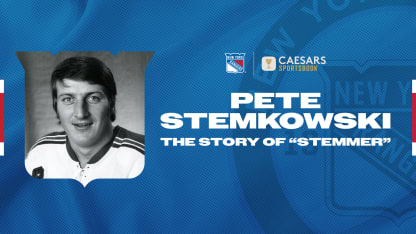When you talk to Pete Stemkowski today, you get at least one of three things from him – a story, a joke, or a trivia question. On many occasions, he will give you all three in a matter of seconds.
It has been nearly half a century since the 81-year-old Stemkowski played his final game for the Rangers, but his ability to recall his tenure in New York – and his entire hockey career – is impeccable. And the stories that he shares encompasses the incredible hockey life that “Stemmer” has had, which included 15 seasons in the NHL as a player, one Stanley Cup championship in the final year of the Original Six era, and one memorable overtime goal that still resonates with Rangers fans today.
It's a story that began in Winnipeg, where Stemkowski was born and raised. As a teenager, he was signed to a “C” form by the Toronto Maple Leafs, which gave them his professional rights as a player; it was at a time shortly before the NHL Amateur Draft came into existence and – as Stemkowski remembered it – he was given $100 by the Maple Leafs for signing the “C” form.
“I could last a whole summer on $100 back then,” Stemkowski said, recalling the interaction he had with a member of the Leafs’ front office. “Having $100 was like having the world to me.”
Stemkowski played with the Winnipeg Monarchs through the start of the 1962-63 season before moving to Toronto to play with the Toronto Marlboros of the Ontario Hockey Association. Most of the Maple Leafs’ best prospects played with the Marlboros, and in 1963-64, Stemkowski showed why he was among them. He finished that season with 103 points in 51 regular season games before helping the Marlboros win the Memorial Cup.
“Stemmer” also made his NHL debut as a 20-year-old during the 1963-64 season, although the one game he played with the Maple Leafs did not go as he would have hoped. “We lost 11-0 to the Bruins,” Stemkowski remembered. “I was laying in my bed and got a phone call on a Saturday afternoon that I had to go to Maple Leaf Gardens that night and play for the Maple Leafs against the Bruins. I was a junior player at the time, but they needed someone and couldn’t call anybody up in time from Rochester of the American League for the game that night.
“After the game, someone asked (Maple Leafs general manager and head coach Punch Imlach) if they would be taking me to Chicago. Imlach said, ‘no way, we embarrassed him enough out there tonight.’ Then they went to Chicago the next night and shut out Bobby Hull, Stan Mikita, and the Black Hawks, 2-0. Go figure!”
Stemkowski only played one NHL game in 1963-64 and then 92 NHL games combined over the next two seasons. By 1966-67 – the final year of the Original Six era – he was a regular in the Toronto lineup, and because of a lineup adjustment from an unlikely source, he would become a part of Maple Leafs lore.
Toronto had lost 10 consecutive games in January and the first part of February in 1966-67, and during that difficult stretch, Imlach was also hospitalized. Imlach’s interim replacement was the legendary Francis “King” Clancy, who decided to play Stemkowski at center on a line with Bob Pulford at left wing and Jim Pappin at right wing. The positive results for the team – and the three players – were immediate.
“We went to practice one day and heard Imlach is in the hospital,” Stemkowski remembered. “Clancy was like your uncle; he was a laid-back guy. The first practice, we were going to do line rushes and he started calling out names. He just called out our three names and told us what positions we were. Pulford told him he was a center, and King just said, ‘Ah, just go to left wing for now.’ So, he went to left wing, and that’s how it started.”
Toronto had a 15-6-3 record over its final 24 regular season games, and Stemkowski had 26 points and a plus-20 plus/minus rating over that span; the 26 points were the fourth-most in the NHL, and the plus-20 rating was the second-best in the league during that time. The Pulford-Stemkowski-Pappin line carried the Maple Leafs into the playoffs, and the team that was referred to as the “Over The Hill Gang” defeated Chicago and Montreal in six games apiece to win the Stanley Cup.
Stemkowski had 12 points in 12 playoff games and factored in on some of the most important goals of the Leafs’ playoff run, as he scored the game-winning goal in Game 5 of the Semifinals in Chicago, set up Pulford for a goal in double overtime in Game 3 of the Stanley Cup Final against Montreal, and assisted on what would be the Cup-clinching goal in Game 6 of the series in Toronto.
“I was a physical guy and I forechecked hard, and I think that helped loosen the puck up in the zone a few times; Pappin was a good outside right winger with a good shot, and Pulford was tough on the boards,” Stemkowski said. “We each had different personalities, and Pulford and Pappin didn’t always get along, but we worked well together as a line.”
Despite his role in helping the Maple Leafs win the Stanley Cup, Stemkowski was traded to the Detroit Red Wings the following season. A few seasons later – early in 1970-71 – he was traded again to the Rangers, where he would spend most of his NHL career.





















